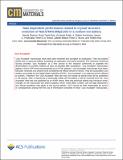Rate dependent performance related to crystal structure evolution of Na0.67Mn0.8Mg0.2O2 in a sodium-ion battery
Abstract
Sodium-ion batteries are considered as a favorable alternative to the widely used lithium-ion batteries for applications such as grid-scale energy storage. However, to meet the energy density and reliability that is necessary, electrodes that are structurally stable and well characterized during electrochemical cycling need to be developed. Here, we report on how the applied discharge current rate influences the structural evolution of Na0.67Mn0.8Mg0.2O2 electrode materials. A combination of ex situ and in situ X-ray diffraction (XRD) data were used to probe the structural transitions at the discharged state and during charge/discharge. Ex situ data shows a two-phase electrode at the discharged state comprised of phases that adopt Cmcm and P63/mmc symmetries at the 100 mA/g rate but a predominantly P63/mmc electrode at 200 and 400 mA/g rates. In situ synchrotron XRD data at 100 mA/g shows a solely P63/mmc electrode when 12 mA/g charge and 100 mA/g discharge is used even though ex situ XRD data shows the presence of both Cmcm and P63/mmc phases. The in situ data allows the Na site occupancy evolution to be determined as well as the rate of lattice expansion and contraction. Electrochemically, lower applied discharge currents, e.g., 100 mA/g, produce better capacity than higher applied currents, e.g., 400 mA/g, and this is related in part to the quantity of the Cmcm phase that is formed near the discharged state during a two-phase reaction (via ex situ measurements), with lower rates producing more of this Cmcm phase. Thus, producing more Cmcm phase allows access to higher capacities while higher rates show a lower utilization of the cathode during discharge as less (if any) Cmcm phase is formed. Therefore, this work shows how structural transitions can depend on the electrochemically applied current which has significant ramifications on how sodium-ion batteries, and batteries in general, are analyzed for performance during operation.
Citation
Sharma , N , Tapia-Ruiz , N , Singh , G , Armstrong , R , Pramudita , J C , Brand , H E A , Billaud , J , Bruce, FRS , P & Rojo , T 2015 , ' Rate dependent performance related to crystal structure evolution of Na 0.67 Mn 0.8 Mg 0.2 O 2 in a sodium-ion battery ' , Chemistry of Materials , vol. 27 , no. 20 , pp. 6976-6986 . https://doi.org/10.1021/acs.chemmater.5b02142
Publication
Chemistry of Materials
Status
Peer reviewed
ISSN
0897-4756Type
Journal article
Description
J.C.P. would like thank UNSW/ANSTO for the PhD Scholarship. N.S. would like to thank AINSE Ltd for providing support through the research fellowship scheme. CIC Energigune work was financially supported by Ministerio de Economía y Competitividad (Proyecto I+D. Retos 2013), reference numbers ENE 2013-44330-R and FPDI-2013-17329, and the Gobierno Vasco/EuskoJaurlaritza (Etortek CICEnergigune 10, SAIOTEK-12 ENERGIBA and IT570-13). P.G.B. is indebted to the EPSRC, including the SUPERGEN programme, for financial support.Collections
Items in the St Andrews Research Repository are protected by copyright, with all rights reserved, unless otherwise indicated.

